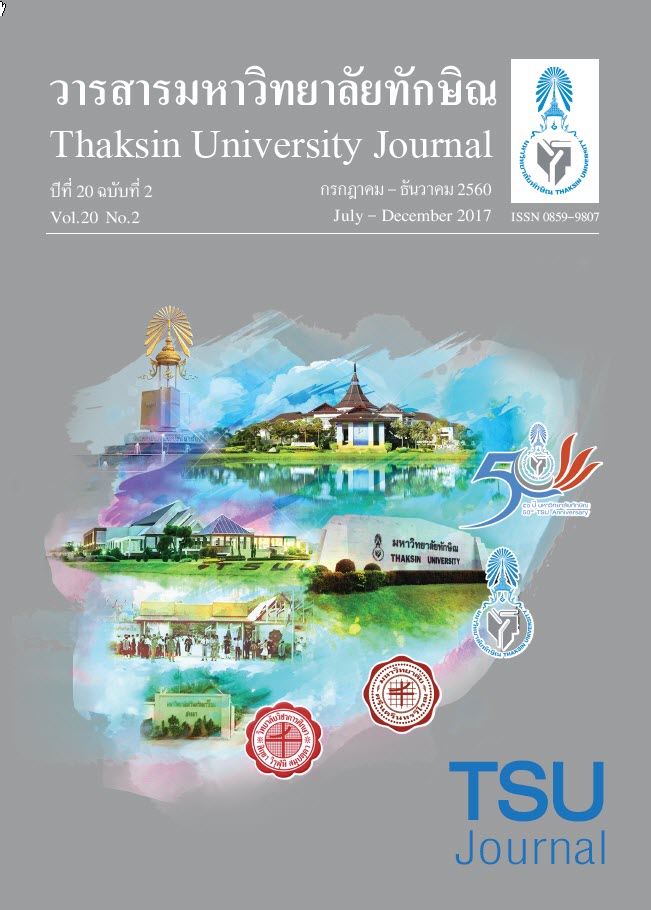Properties of Natural Rubber Filled with Silica from Rice Husk Coated with Polyethylene
Main Article Content
Abstract
This study aimed to investigate cure characteristics and tensile properties of natural rubber filled with
silica from rice husk coated with polyethylene. The rice husk silica (SC/RH) was obtained after calcination rice husk at 700˚C. The results show that SC/RH containing 99% of silica with amorphous structure. The SC/RH was improved with polyethylene (PE) through in situ polymerization comparing with the commercial silica (SC/com). It was found that the silica surface was coated with PE. For further study, untreated silica (SC/RH and SC/com) and PE treated silica (SC/RH-PE and SC/com-PE) were introduced as filler into natural rubber (NR). The experimental results obviously show that the decrease in cure time and the increase in torque difference and tensile strength of NR composites with incorporation of PE treated silica. This is due to the reduction of the adsorption of curing accelerator and filler-filler interaction on the silica surface via PE leading to the improvement in rubber - filler interaction which corresponded well with bound rubber result.
Article Details
References
Nostrand Reinhold.
[2] Mark, J.E., Erman, B. and Eirich, F.R. (2005). The Science and Technology of Rubber (3rd edition).
New York: Elsevier Academic.
[3] Hewitt, N. (2007). Compounding Precipitated Silica in Elastomers (1st edition). New York: William
Andrew Inc.
[4] Choi, S., Chung, K.H. and Nah, C. (2003). “Improvement of properties of silica-filled styrene-butadiene
rubber (SBR) compounds using acrylonitrile-styrene-butadiene rubber (NSBR)”, Polymer Advance
Technology. 14, 557-564.
[5] Ansarifar, A., Nijihawan, R., Nanapoolsin, T. and Song, M. (2003). “Reinforcing effect of silica and silane
fillers on the properties of some natural rubber vulcanizates”, Rubber Chemistry Technolology.
76, 1290-1310.
[6] Luginsland, H.D., Frohlich, J. and Wehmeier, A. (2002). “Influence of different silanes on the reinforcement
of silica filled rubber compounds”, Rubber Chemistry Technolology. 75, 563-579.
[7] Sae-Oui, P., Thepsuwan, U. and Hattapanit, K. (2004). “Effect of curing system on reinforcing efficiency of
silane coupling agent”, Polymer Testing. 23, 397-403.
[8] Sooyeon, K., Eunhye, K., Sungsoo, K. and Woosik, K. (2005). “Surface modification of silica nanoparticles
by UV-induced graft polymerization of methyl methacrylate”, Journal of Colloid and Interface
Science. 292, 93-98.
[9] Jianfei, C., Baoyong, L., Xujie, Y., Lude, L. and Xin, W. (2005). “Graft polymerization onto nano-sized SiO2
surface and its application to the modification of PBT”, Journal of Materials Letters. 59, 1603-1609.
[10] Chuayjuljit, S., Eiumnoh, S. and Potiyaraj, P. (2001). “Using silica from rice husk as a reinforcing filler in
natural rubber”, The Journal of Scientific Research Chulalongkorn University. 26, 127-138.
[11] Sombatsompop, N., Thongsang, S., Markpin, T. and Wimonmala, E. (2004). “Fly ash particles and
precipitated silica as fillers in rubbers. I. Untreated fillers in natural rubber and styrene–butadiene
rubber compound”, Journal of Applied Polymer Science. 93(5), 2119–2130.
[12] Phewphong, P., Saeoui, P. and Sirisinha, C. (2008). “Mechanism of silica reinforcement in CPE/NR blends
by the use of rheological approaches”, Journal of Applied Polymer Science. 107, 2638-45.
[13] Choi, S. (2001). “Influence of the silica content on rheological behaviour and cure characteristics of silica
filled styrene-butadienen rubber compound”, Polymer International. 50, 525-530.


